November 2002 (Part 2)
SELECTION OF QUESTIONS AND ANSWERS
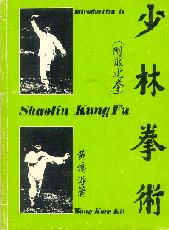
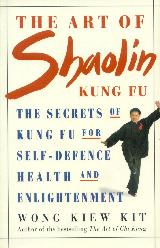
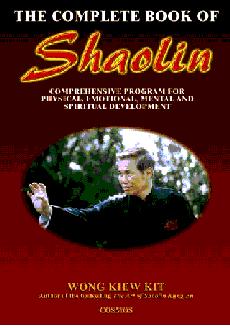
Shaolin books by Sifu Wong Kiew Kit, from left: Introduction to Shaolin Kung Fu, 1981; The Art of Shaolin Kung Fu, 1996; The Complete Book of Shaolin, 2002.
Question 1
When I was about 8 years old I remembered watching David Carradine on the television in the series “Kung Fu”. I liked his main master (the one who called himself “Grasshopper”) very much and I was genuinely inspired with the noble ideals and aims of Shaolin Kung Fu.
— Paul, England
Answer
Carradine's book, “The Spirit of Shaolin”, was very well written and inspiring. Nevertheless, there were a few factual mistakes in his book. While the teaching presented in the book was beautiful, Carradine mistook Shaolin philosophy and tradition to be Taoist when they are actually Buddhist. Indeed, it was to correct some of these mistakes that prompted me to write my book, “The Art of Shaolin Kung Fu”.
Moreover, Carradine himself did not know Shaolin Kungfu although he acted very well as a kungfu master in the television series.
You are right about the nobility of aims and ideals of Shaolin Kungfu, but you and most people, including many Shaolin masters today, are probably unaware that they are much more noble and grander than even you think.
A noble Shaolin Kungfu practitioner aims not just to be a great fighter leading a most honorable life; he aims to transcend beyond life and death! Nevertheless, many people, including many who practice Shaolin Kungfu, do not believe such an aim is attainable, or even possible.
The Shaolin ideal is to be a warrior-monk, one who is not only righteous and courageous, but also full of compassion and cosmic wisdom. You can read about these aims and ideals in my latest Shaolin book, “The Complete Book of Shaolin”.
Question 2
I remember quite clearly in the television series how, when as a young boy he went to enter the monastery, the head of the monastery poured tea for all the boys attempting to enter and one cup of tea for himself. All the other boys drank the tea before the master except for David Carradine, who waited until the master drank first. All the other boys were asked to leave except him. He was eventually accepted and began to train.
Answer
In kungfu culture, a student would not eat or drink until his master did so, or told by his master to do so. You can find more information in my webpage, Showing Respect to the Master.
The great respect shown to the master is for the students' sake. A great master does not care much whether his students show him more respect or show his dogs, but the culture of respect gives the students the ideal situation to derive the best benefits from their training.
Question 3
I remember too, how, upon his meeting with the blind aged master, the master said something to him about a grasshopper at his feet. The boy said: “Old man, how is it that you can hear the grasshopper at my feet?” To which the master replied: “Young man, how is it that you do not”. This has stayed with me so strongly. I can even see the scene in my mind's eye all these years later.
Answer
The lesson behind this episode is invaluable. We are often prejudiced and see things only from our perspective, regarding other perspectives as wrong. There are many such cases in daily life.
Take my name, Wong Kiew Kit, as an illustration. Many Westerners think that my first name is Wong Kiew, and my surname is Kit. So they address me as Sifu Kit or Mr Kit.
That is incorrect. My name is Kiew Kit, and my surname is Wong. So they ask, “Why do the Chinese put things upside down?” This is an example of seeing things only from their perspective. Actually, from another perspective, it is the Westerners who put their names the reversed way, and it becomes problematic when we attempt to arrange names in alphabetical order as in a bibliography list. John Smith, for example, will not be listed as John Smith but as Smith, John. Such problems do not occur in Chinese names.
A more serious, though less obvious, situation occurs in medicine and health. Most people today, including those in Eastern countries like Singapore and Japan, view medicine and health from the Western medical perspective. If they were sick with what in the West would be called hypertension, for example, and were told that their problem lied not in their heart or blood vessels but in their liver, they would not believe. Yet, the fact is that by working on their liver system, Chinese physicians could overcome their hypertension problem.
Question 4
Back to the marital arts shop in Manchester: the man serving rummaged around for a while and eventually came back and said “I've only got this one”. I looked through it and knew instinctively it was what I had been looking for. It was your book called “Introduction to Shaolin Kung Fu”.
Answer
“Introduction to Shaolin Kung Fu”, published in 1981 but written a few years earlier, was the first book I wrote. Since then I have ten other books published, including two on Shaolin Kungfu, “The Art of Shaolin Kung Fu” in 1996 and “The Complete Book of Shaolin” in 2002.
Although I found “Introduction to Shaolin Kung Fu” amateurish compared to my other books written when I was more skilful in writing, a few people like it the best, because, amongst other things and to cite Douglas, my most senior disciple in Europe, it shows my teaching in my Eastern tradition, before I was influenced by the “softness” of Western students.
But, despite its popularity and having gone through three reprints, it is now out of print. I shall get it back to print in the near future.
Personally I like “The Complete Book of Shaolin” the best. It presents the Shaolin arts in great scope and depth. You will read not just on Shaolin Kungfu, but also on Shaolin Chi Kung and Zen. You will probably be amazed at the cosmic wisdom revealed in the Zen of Shaolin masters.
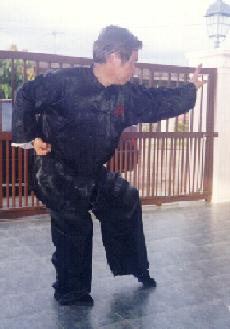
A Shaolin kungfu pattern called "Single Tiger Emerges from Cave" demonstrated by Sifu Wong
Question 5
I began to practice, although it was difficult for me at first to manage all the warm-up exercises, particularly the leg stretch. I practiced for over a year and all that time was looking for a teacher. I failed to find one. However, I did find someone who taught Yang Style Tai Chi. At that point, I stopped my Shaolin Kung Fu and concentrated instead on Tai Chi as I now had a master to teach me rather than relying solely on a book and myself.
Answer
How well one can learn from a book depends on an interaction of three factors: the book, the material to be learnt, and the reader.
Books come in great varieties. Some books are written to entertain, some to instruct, some to record in an arcane manner, and a few to spread rubbish.
Some materials presented in books are straight-forward instructions any sensible readers can follow readily, some are so confusing that one rightly suspects whether the authors themselves knew what they had written, and some deal with advanced skills which are difficult to practice even if they are clearly explained.
Some readers are fresh beginners who think they can become masters by reading a few books, some are dedicated students searching for insight and direction, others are already masters themselves reading to widen their knowledge.
If you are a kungfu master reading on some combat techniques, you would have no difficulty comprehending even if the material is presented in jargons. Here is one example: When an opponent attacks with a Black Tiger, respond with Taming the Tiger. Of course, if you are not a master and do not know what Black Tiger and Taming the Tiger are, you would not understand even though you know the dictionary meaning of every word.
If you are a beginner reading a chi kung technique, you would have much difficulty practicing correctly even if the material is clearly and correctly presented. Try this example: Stand upright and be relaxed, and think of nothing. The instruction is simple and clear. Most beginners would think they can carry out the instruction correctly, but actually most of them cannot and they would not realize their mistakes in their self-taught practice. Most, for example, could not relax and could not free their mind of irrelevant thoughts.
Question 6
I spent almost two years in this class but unfortunately it became quite apparent (for several reasons) that the master was more interested in the fees than the teaching. I found another martial art teacher whom I thought was good. I did some courses with him but I just didn't feel comfortable at the sessions
Answer
Unless they are saints or fools, virtually all teachers are interested in the fees their students pay them. There are different reasons for their interest. Two major ones are they need the fees to live, and the amount the students are willing to pay indicates the extent to which the students are dedicated.
The relation between their interest in the fees and their interest in the teaching also varies. If they are only interested in the fees and not interested at all in the teaching, it is logical that you should not learn from them, unless you cannot help it. Some university professors, for example, are obviously not interested in their teaching, though they may be interested in other aspects of their work, such as their research. But students still have to bear with them.
Feeling comfortable with your teacher is also important, and in arts like kungfu and chi kung, it is more important than his fees and his teaching interest. It is because the teaching is often intuitive and experiential, and transmitted non-verbally -- physically as well as spiritually. If one is uncomfortable with his teacher, he would unconsciously block such transmission.
Question 7
I have also bought your book “The Art of Chi Kung” and have tried to practice some of the exercises. However, now that I am going to the gym — and getting somewhat fitter — I find that I just don't have the energy to do both Chi Kung and the gym at the moment. I know Chi Kung will give me energy but I feel that after my brush with my old Tai Chi teacher that I would rather take my time and look for a real teacher before I fully commit to Chi Kung. You can only do so much on your own, and I am concerned about doing it incorrectly with no teachers to help me.
Answer
If you practice chi kung, you would have more energy -- and also more time -- to go to the gym or do any other things. Many people may find this statement odd. It is because they have not practiced chi kung, though some of them may have performed external chi kung forms. They think of chi kung as physical exercise, which consumes both time and energy. Hence if one did chi kung, they wrongly reason, he would have less time and energy.
When you practice chi kung -- real chi kung, not just external chi kung forms -- you will have more time and energy. This is a fact, and has been confirmed by many of my students. Many have told me that since practicing chi kung they have time to play games, to take their family out, to go for holidays, or simply to sit back and enjoy the sunset or music. Before that they only worked, and had not enough time for their work. Now they spend less time working, but produce more and better work, and they enjoy their work.
You are wise to realize the great benefit of learning personally from a good teacher, instead of from his books or on your own. Of course there is a price to pay. If you learn from his books you learn in the comfort of your own house at your convenient time; if you learn from him personally you have to travel, sometimes over great distance, to see him, and his fee is usually more than what you pay for his books. But the rewards far outweigh the price. You will, for example, have more time and energy for your family and your hobbies, and you will enjoy your work. It is unlikely you will have such benefits by learning from books. Even if you have, the quality of the benefits will be vastly different.
Question 8
There is one question I have if I may ask you: In your section on behaving correctly you say that students should call the teacher “Sifu”. If I were to call you “Sifu” does this not imply that you are my teacher? I would feel rather presumptuous about calling you Sifu unless you have agreed to accept me as a student. I have read somewhere that the term also translates as something like “daddy”. Is this correct?
Answer
The term “sifu” literally means “teacher-father”. It is in Cantonese pronunciation. In Mandarin (or pinyin) it is “shifu”.
In traditional kungfu and chi kung culture, students never call their teacher by name. Doing so would be considered very rude. They call their teacher “sifu”. Other people, such as the public in general, may also call a master “sifu”, although they frequently use the term “sifu” with the surname of the master. For example, many people who are not my students call me “sifu”, others call me “Sifu Wong”.
Strictly speaking, if someone calls me "sifu" and I accept it, it means I accept him as my student. Hence, students feel very proud to call their teachers who happen to be great masters "sifu". But in Chinese custom, meanings are denoted not just by words but also by other factors like tone, attitude, behavior and environment. When someone from the public calls me ”sifu", it is clear to both sides and others that he is polite and respectful, and that my answering does not constitute my accepting him as a student.
In Chinese societies, the term “sifu” is applicable not just to kungfu and chi kung masters. It is also used for experts in other fields. Experts in tailoring, cooking, carpentry as well as Buddhist monks and nuns, for example, are often addressed as “sifu”. Sometimes, out of politeness, one may call his tailor “sifu” though the dresses may be made out of size.
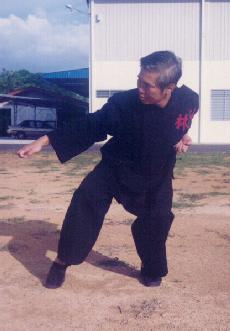
Another Shaolin kungfu pattern called "Angry Leopard Charges at Rock" demonstrated by Sifu Wong
Question 9
My son is a student of Ying Jow Pai. He saw some young boys performing Tongzi Gong. He has been asking me for months for an instructional tape to teach him these young boy's exercises. I have looked all over the internet and I only found one that only demonstrates and is not instructional. Is there another name for these routines or different spelling. It seems like it would be a good supplement to his other system. If you know of any information that might help it would be greatly appreciated.
— Jon. USA
Answer
“Tongzi Gong” literally means the “Art of Children”, but I believe a more appropriate figurative translation is the “Art of Becoming Childlike”.
There are different versions and levels of attainment of Tongzi Gong. At the lowest level, it consists mainly of physical exercises to make the body strong and pliable, like that of a child. At the highest level, it is a form of advanced chi kung where the practitioner is not only agile and childlike although he may be over 60 years old, but also can take strikes on his body, including at his groins, without sustaining injury. At this highest level, the practitioner has to abstain from sex.
What your son saw was probably the low level version. Obviously, the high level version is not suitable for him, even when he has become an adult.
Low level Tongzi Gong is mainly stretching exercises, which your son can learn from the demonstration you obtained over the internet. It is quite safe to practice these exercises on his own so long as he does not tense himself but practice in a relaxed manner. It is a good supplement to his Ying Jow Pai, or Eagle Claw Kungfu.
Question 10
I have your top book, “The Complete Book of Tai Chi Chuan”, and it was a good help to upgrade my knowledge. I have been training Yang Style for some years and now I would like to know more about Wudang. Which book of Wudang Tai Chi is the best, and how can I get the pictures of Wudang forms from the internet?
Answer
Wudang is pronounced as “wu t'ang” and not as “wu dang”, as those unfamiliar with Romanized Chinese often do, pronouncing it the way it is spelt in English. The Wudang Mountain was where Zhang San Feng first evolved Shaolin Kungfu into Wudang Kungfu, which was later called Taijiquan (Tai Chi Chuan).
Taijiquan was passed on to the Chen Family, and later to the Yang Family. Hence, we now have Chen Style Taijiquan and Yang Style Taijiquan.
Relatively speaking, Wudang Taijiqaun paid much emphasis on spiritual cultivation, Chen Style Taijiquan on combat, and Yang Style Taijiquan on health. This was only relative, as spiritual cultivation, combat application and health benefits are found in all styles of traditional, genuine Taijiquan. However, modern Taijiquan, as one of the main categories of modern wushu, is more of a demonstrative dance.I do not know of any good books in English or good pictures in the internet on Wudang Taijiquan.
Nevertheless, even if you can get descriptions and pictures from books or the internet, it is unlikely you can get the essence of Wudang Taijiquan from them, for which you have to learn from a master.
